绩效考核标准(中英文)
员工绩效考核表KPI(中英文对照)
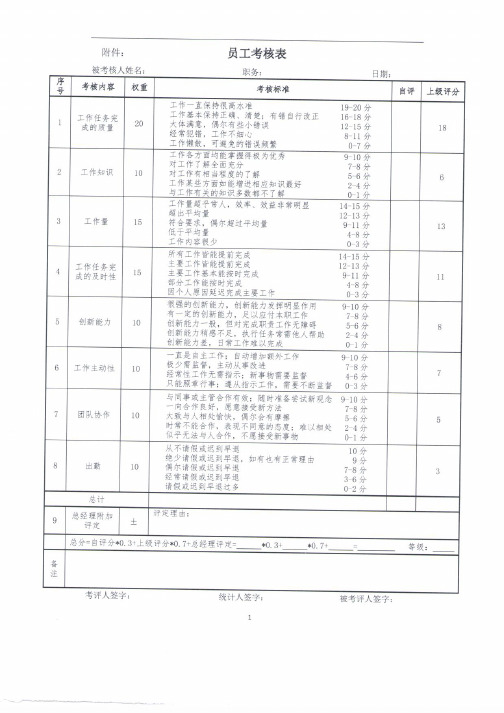
0-7
excellent in all aspects of the work area
9-10
2
specialized
knowledge
comprehensive and sufficient understanding in work area 10 considerable understanding in work area
0-1
never ask for leave, be late or leave early
10
seldom ask for leave, be late or leave early ecsept for reas10 ask for leave, be late or leave early occasionally
4-8
delay the main work for personal reasons
0-3
great innovation ability and play a significiant role
9-10
with innovation abilty and can cope with the job
4-6
work only follow the instruction and need monitor
0-3
effective cooperation with workmates or supervisor, ready to accept new 9-10
good cooperation, willing to accept new methods
16-18
1 work quality
20 generally good with little errors some time
员工绩效考核方案-中英文对照
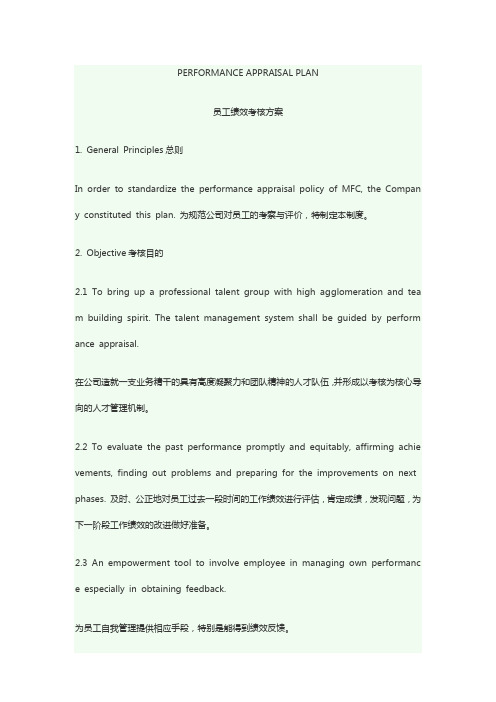
PERFORMANCE APPRAISAL PLAN员工绩效考核方案1. General Principles总则In order to standardize the performance appraisal policy of MFC, the Compan y constituted this plan. 为规范公司对员工的考察与评价,特制定本制度。
2. Objective考核目的2.1 To bring up a professional talent group with high agglomeration and tea m building spirit. The talent management system shall be guided by perform ance appraisal.在公司造就一支业务精干的具有高度凝聚力和团队精神的人才队伍,并形成以考核为核心导向的人才管理机制。
2.2 To evaluate the past performance promptly and equitably, affirming achie vements, finding out problems and preparing for the improvements on next phases. 及时、公正地对员工过去一段时间的工作绩效进行评估,肯定成绩,发现问题,为下一阶段工作绩效的改进做好准备。
2.3 An empowerment tool to involve employee in managing own performance especially in obtaining feedback.为员工自我管理提供相应手段,特别是能得到绩效反馈。
2.4 To support an employee’s efforts of successful development and supply t he personal information and decision gist on salary, welfare(including stock o ption )adjustment and training plans.支持员工职业发展,为员工薪酬待遇(含员工持股权调整)以及相关的教育培训提供人事信息与决策依据。
绩效考核的五个标准英文
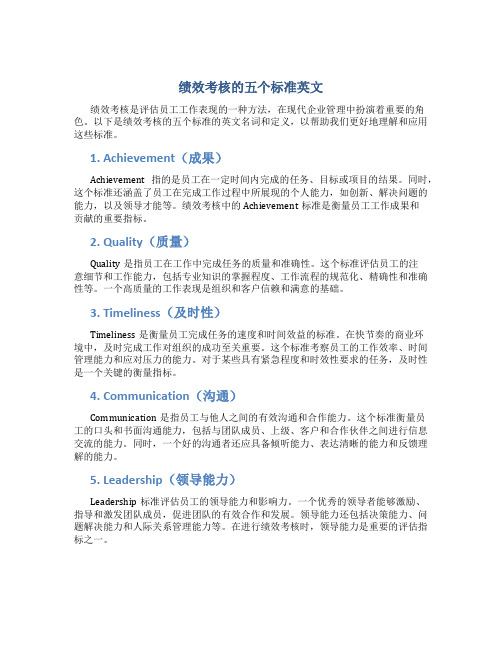
绩效考核的五个标准英文绩效考核是评估员工工作表现的一种方法,在现代企业管理中扮演着重要的角色。
以下是绩效考核的五个标准的英文名词和定义,以帮助我们更好地理解和应用这些标准。
1. Achievement(成果)Achievement指的是员工在一定时间内完成的任务、目标或项目的结果。
同时,这个标准还涵盖了员工在完成工作过程中所展现的个人能力,如创新、解决问题的能力,以及领导才能等。
绩效考核中的Achievement标准是衡量员工工作成果和贡献的重要指标。
2. Quality(质量)Quality是指员工在工作中完成任务的质量和准确性。
这个标准评估员工的注意细节和工作能力,包括专业知识的掌握程度、工作流程的规范化、精确性和准确性等。
一个高质量的工作表现是组织和客户信赖和满意的基础。
3. Timeliness(及时性)Timeliness是衡量员工完成任务的速度和时间效益的标准。
在快节奏的商业环境中,及时完成工作对组织的成功至关重要。
这个标准考察员工的工作效率、时间管理能力和应对压力的能力。
对于某些具有紧急程度和时效性要求的任务,及时性是一个关键的衡量指标。
4. Communication(沟通)Communication是指员工与他人之间的有效沟通和合作能力。
这个标准衡量员工的口头和书面沟通能力,包括与团队成员、上级、客户和合作伙伴之间进行信息交流的能力。
同时,一个好的沟通者还应具备倾听能力、表达清晰的能力和反馈理解的能力。
5. Leadership(领导能力)Leadership标准评估员工的领导能力和影响力。
一个优秀的领导者能够激励、指导和激发团队成员,促进团队的有效合作和发展。
领导能力还包括决策能力、问题解决能力和人际关系管理能力等。
在进行绩效考核时,领导能力是重要的评估指标之一。
以上是关于绩效考核的五个标准的英文名词和定义的详细介绍。
这些标准可以帮助企业更全面地评估员工的绩效表现,从而为员工的个人和职业发展提供有价值的反馈和指导。
绩效评估-中英文对照
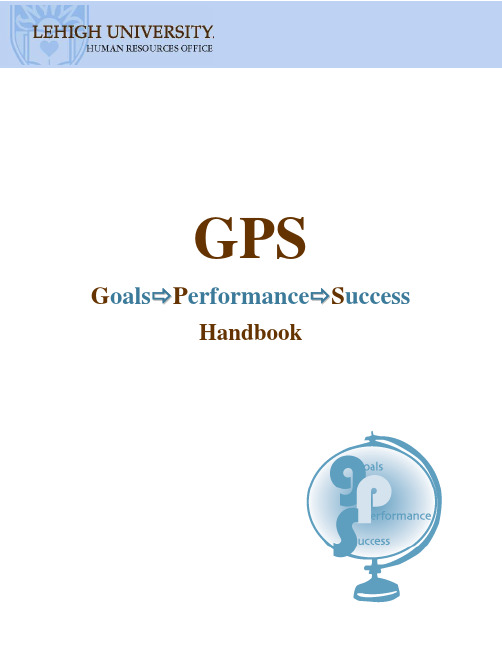
GPSG oalsÖP erformanceÖS uccessHandbook(This page is intentionally blank.)Table of Contents1. Introduction to Performance Management 4Started 62. Getting3. Job Family Compass Guides and Success Factors 67Self-Appraisal4. TheEvaluation 8 5. The8Setting6. Goal7. Workplace Learning and Performance 118. Diversity 119. Evaluating Employees in Supervisory Roles 1212Improvement10.PerformanceSupporting Performance Improvement13IncreasesAnnualMerit11.MonthFollow-ups 13 Six12.toAvoid 14 Things13.Questions 14 Asked14.FrequentlyIntroduction to Performance Management (PM)The performance appraisal process at Lehigh University is designed to be a formal part of the ongoing two-way conversation between the employee and the supervisor. Appraising employee performance is one of the most important job responsibilities associated with the role of supervision. An effective appraisal requires the supervisor to set performance standards and goals, clearly communicate performance expectations, support employees in accomplishing set goals, and evaluate the impact/outcome of employees’ performance. This is referred to as performance management (PM). The supervisor’s role in performance management and in the performance appraisal process is that of a coach.There are three components of the ongoing performance management process:1.Setting expectations (goals and objectives)2.Ongoing tracking and feedback3.Reviewing results.Setting expectations begins when an employee is hired, transferred, or promoted to another position at Lehigh. All classified staff positions at Lehigh have position descriptions (PDs). Managers and supervisors are responsible for providing new employees with their position description. The provisional period of employment (90 days for most staff positions) is the initial opportunity to set expectations and establish goals and objectives. Beyond the provisional period, goals need to be established annually and reviewed and updated as necessary. Individual goals should align with area and University goals. It is good practice to review goals at the mid-year point in the performance management cycle.Staff members are responsible for tracking progress toward established goals and discussing progress with their supervisor. The supervisor’s role is to provide balanced feedback and coach staff to enhance performance. Performance discussions need to occur on a regular basis. Staff members should track progress throughout the year so that the information can be used for the self-appraisal.Reviewing results is the culmination of the performance management cycle. Performance is formally evaluated based on results and outcomes of the established goals documented in the Goals→Performance→Success(GPS) online tool, and discussed by the staff member and the supervisor. This is also the time new goals are established for the next evaluation period.The performance appraisal is the third phase of performance management – reviewing results. It is also the first phase – setting expectations. It is not only to look back over the past year, but more importantly, to look forward to the coming year, to discuss what needs to be accomplished professionally, and how the employee will contribute to the departmental goals. The supervisor and employee should also discuss and identify workplace learning programs necessary to enhance and expand the employee’s skills in order to ensure the completion of departmental goals and the stem’s strategic plan.About GPSIn 2006, the University launched the Performance Management Project. A steering committee comprised of staff representing most University stems, was appointed and designed a newprocess for evaluating staff performance. The new process is called GPS for Goals→Performance→Success.The GPS process is based on job accountabilities and related goals. Key accountabilities were established in the PDs created a few years ago. Goals and objectives established for employees during last year’s process will be included in the evaluation and linked to the key accountabilities. GPS is a process of shared responsibility between the supervisor and the staff member. The GPS online tool displays a workflow that will help guide staff members and supervisors through the process. Quick guides, user guides and online presentations will be available in addition to hands on GPS training sessions.In addition to key job accountabilities, the following aspects are important in the appraisal process:1.Setting Goals and Objectives: The full implementation of GPS in 2008 is heavilydependent on goals established during last year’s appraisal process. In addition toproviding the framework for next year’s appraisal, setting goals and objectives providesthe opportunity for employees to understand how their individual goals link to thestrategic plan for the department and the stem. Goals and objectives established duringthis performance cycle will be reviewed and evaluated in next year’s performanceprocess.2.Self-appraisals have always been a recommended part of the appraisal process but nowthey become even more important. Employees who complete a self-appraisal demonstrate the fourth Core Success Factor: Take ownership for personal learning and development.(See page 5 for more information on success factors.)3.Workplace Learning and Performance was previously referred to as “training anddevelopment” and identifies the resources that aid employees in meeting their job goalsand stretching their job knowledge.Performance management is an ongoing process, not a one-time discussion. A six-month follow-up to the annual appraisal is encouraged, but it is important to monitor performance and provide timely, specific, and balanced feedback when appropriate.Performance planning gives meaning to what people do and it makes their work more interesting. During the Lehigh All-Staff Employment Rewards (LASER) project launched in 2005, Lehigh staff members affirmed that they wanted interesting and engaging work. One planning tool available to managers and supervisors is the performance appraisal process. Performance planning also ensures that we all work toward the same goal. Employees may not understand how their work contributes to achieving the department and stem goals. It is the supervisor’s responsibility to communicate and act as a catalyst so the employee understands his or her role in achieving the institutional goals.Feedback is an integral part of performance management. As mentioned above, feedback needs to be timely, specific, and given frequently. Therefore the performance appraisal should be a review of feedback given throughout the year. Feedback is a motivational tool. When employees are told specifically how they did a good job, it emphasizes the desired level of performance and motivates employees to achieve that same level in other areas of their work. Feedback can also be a motivational tool for the employee who has not been performing at the expected level. Themanager should discuss the current level of performance, the expected level of performance, and ask the employee to develop a plan for achieving the desired level of performance. Feedback on significant and incremental improvement is equally important to the employee’s growth and professional development.“No news is good news” does not apply to the performance management process. When an individual does not receive a performance appraisal, the communicated message is not a positive one. At the onset of the performance appraisal process, the president, provost, vice presidents, and deans communicate that performance appraisals are mandatory for exempt and nonexempt staff. HR tracks the return of performance appraisals and contacts the immediate supervisor and the appropriate dean or vice president when appraisals are not returned. Surprising as it may seem, most individuals would rather learn if their performance is less than satisfactory and why, than to not receive any appraisal.When a supervisor meets with employees regularly to discuss performance and provide feedback and keeps a record of accomplishments, completing the annual performance appraisal should not be an arduous task.Getting StartedWhere to start can be difficult, but there are a number of ways to prepare to evaluate an employee’s performance over the past year. Supervisors should consider reviewing one or more of the following:•Position description•Job Family Compass Guide (can be found on the Campus Portal or obtained from HR)•Employee’s self-appraisal•Notes from meetings with the employee•Feedback from key people with whom the employee interacts regularly (contact HR for suggestions in doing so)•Last year’s performance appraisal which may contain goals for the current performance cycle.Job Family Compass Guides and Success FactorsThe Compass Initiative paved the way for the Performance Management project with the completion of the Job Family Compass Guides. The Job Family Compass Guides provide several tools to aid managers in the performance management process. Managers can refer to the Compass Guide for information on key accountabilities and knowledge, skills, and abilities for the job. Key accountabilities describe what needs to be accomplished in the position. Each Compass Guide includes the Core and Managerial Success Factors as well as Functional Success Factors developed by and for members of the job family. Core and Managerial Success Factors are listed on page 7. Success factors describe how to perform the key accountabilities of the job. The Staff Development Resource Guide provides information for workplace learning and professional development. Job Family Compass Guides are available on the Campus Portal.Core Success Factors: Managerial Success Factors:1.Support Lehigh’s Mission and Goals2.Embrace and Adapt to Change3.Accountability for Work Achievements4.Take Ownership for Personal Learningand Developmentmunicate Effectively6.Demonstrate Creativity and Innovation 1.Build a Community2.Set a Strategic Vision3.Manage and Facilitate Change4.Coach Staff for Excellent Performance5.Foster a Learning Environmentmunicate to Ensure EffectivenessThe Self-AppraisalSelf-appraisals have always been a recommended part of the appraisal process due to the importance of understanding how the employee views his or her performance. The completion of self-appraisals by all employees was a key goal in the 2007 process and is equally important in the 2008 process and beyond. When employees complete self-appraisals, they demonstrate Core Success Factor #3, which states: Take accountability for work achievements. The self-appraisal can easily be accomplished by asking the employee to complete the “Progress and Outcomes” and “Comments” areas on the GPS online tool. Employees may also rate their performance for each key accountability as part of the self-appraisal. Asking employees to list goals and objectives and workplace learning suggestions for the upcoming year allows them the opportunity to express interest in their career development.It is important that employees know what is expected of them and by when. An early start ensures time for employees to complete a self-appraisal, allows time for employees to digest the appraisal prepared by the supervisor, and also allows time for the employee to respond to the appraisal in the “Performance Summary” section on the GPS online tool before returning the completed form to the supervisor. Schedules will vary by stem. Supervisors should consult their stem leadership. A sample schedule follows.Sample departmental schedule:December 8 Start of performance appraisal process. Supervisor requests all employees complete self-appraisals using the online GPS tool. Supervisor identifies adue date of January 9, 2009.January 9 Date self-appraisals are to be forwarded to the supervisor.January 12 – 23 Supervisor reviews self-appraisals, completes performance appraisals for all staff members, and reviews performance appraisals with next levelsupervisor (if necessary).January 26 – 30 Supervisor schedules performance meeting allowing sufficient time to review all completed sections of the appraisal. (HR recommends 90minutes.) When a supervisor forwards the online appraisal to the“Performance Meeting” step it becomes available for the employee toreview the supervisor’s ratings and comments. Supervisor and employeemeet to discuss the appraisal.February 2 – 6 Employee completes the “Summary Statement” section and finalizes “2009 Performance Goals and Objectives.”The EvaluationThe supervisor’s evaluation of the staff member takes place following the completion of the self-appraisal. Using the workflow established in the GPS online tool, the staff member will forward the self-appraisal to his or her supervisor. The supervisor will select a rating from the drop down menu that best reflects the direct report’s level of performance for each key accountability and related goal(s). Supervisors are encouraged to add comments and enter or edit weights for the key accountabilities and special projects (if applicable). Supervisors are also encouraged to set goals for the next performance cycle and identify workplace learningfor the employee.Goal SettingGoal setting is a very important part of the performance appraisal process and identifies where employees should focus their efforts to effectively meet objectives during the course of the year. This is the first step in completing the performance appraisal. Look at goals and objectives from the prior year and comment on the results. Many of Lehigh’s stems and colleges have prepared strategic plans.The achievement of goals and objectives is important but goals and objectives are a plan and need to be flexible to accommodate change in workplace priorities. In many cases unexpected activities or significant changes affect the employee’s ability to complete the goal. If a goal from the previous year was not completed, document the reasons why. These circumstances can be noted directly on the GPS online tool in the “Progress and Outcomes” area for the related key accountability and associate goal. Notes can also be made in the “Notes” function of the PM form.Use the S.M.A.R.T. goal-setting process to establish goals and objectives. This process helps ensure that both supervisors and staff members share the same understanding and clarity on goals set during the performance management cycle.Differentiating between a goal and an accountability:y An accountability is a statement about normal work output… a clearly defined and established ongoing responsibility or requirement of a job. Accountabilities and associated supporting activities are found on the position description. They describe what the person in that position is responsible for regularly producing or providing. Ask, “What are the normal expected outcomes of the position?”y A goal is a general statement about a desired outcome with one or more specific objectives that define in precise terms what is to be accomplished within a designated time frame. A goal may be performance-related, developmental, a special project, or some combination.Types of performance, developmental, and special project goals:y A performance goal is usually linked to an accountability and could involve problem-solving, innovating, or implementing some type of improvement.y A developmental goal may serve to enhance performance in the current role (greater depth of knowledge/skills) or prepare for a new or future role.y Special projects could include a “stretch” assignment (build experience), be based on the departmental plan, or meet a particular organizational need.Setting S.M.A.R.T. Goals:Goals should describe accomplishments, not activities. First,let’s look at what the S.M.A.R.T. acronym means …Specific: Goal objectives should address the … who, what, when, where, and how. Make sure the goal specifies what needs to be done, with a timeframe for completion. Use action verbs … create, design, develop, implement, produce, etc. Example: Resolve accounting discrepancies within 48 hours.Measurable: Goal objectives should include numeric or descriptive measures that define quantity, quality, cost, etc. How will you and your staff member know when the goal has been successfully met? Focus on elements such as observable actions, quantity, quality, cycle time, efficiency, and/or flexibility to measure outcomes, not activities. Example: Secure pledges from ten new donors by the end of each week.Achievable: Goal objectives should be within the staff member’s control and influence; a goal may be a “stretch” but still feasible. Is the goal achievable with the available resources? Is the goal achievable within the timeframe originally outlined? Consider authority or control, influence, resources, and work environment support to meet the goal. Example: Obtain the XYZ professional certification within two years.Relevant: Goals should be instrumental to the mission of the department (and ultimately, the institution). Why is the goal important? How will the goal help the department achieve its objectives? Develop goals that relate to the staff member’s key accountabilities or link with departmental goals that align with the institutional agenda. Example: Develop and implement a diversity recruitment plan that increases the number of diversity candidates by ten percent.Time-bound: Goal objectives should identify a target date for completion and/or frequencies for specific action steps that are important for achieving the goal. How often should the staff member work on this assignment? By when should this goal be accomplished? Incorporatespecific dates, calendar milestones, or timeframes that are relative to the achievement of another result (i.e., dependencies and linkages to other projects). Example: Check the fire alarms and emergency lighting in all buildings every six months.Let’s look at some more examples:For an organization or department…Not SMART “Improve our student service.”SMART “Achieve and maintain an average student service rating of at least 4.0 (out ofa possible 5.0) on our annual survey by 11/20/09.”For an exempt staff member…Not SMART “Create departmental plan.”SMART “Create a 2009 operational plan for the new departmental initiative. Obtain final approval from stem leadership and discuss it with our department soindividuals can begin setting their performance objectives by 1-29-09.”Not SMART “Improve project management skills.”SMART“Take the Project Management Essentials workshop on 10-18-2008, report what was learned to our team by 11-01-2008, and apply the relevant conceptswhile implementing our 2009 marketing plan.”For a nonexempt staff member…Not SMART “Send out welcome letters to our new students.”SMART “Produce and distribute personalized welcome letters, error-free, to all new students in our department by 9-26-09.”Not SMART “Be more receptive to coaching suggestions and feedback.”SMART “At our monthly progress meetings, ask for feedback on what is going well and what things to improve. Keep a notebook with this information, try outthe suggestions, and document each week what worked and what didn’t.”For an exempt or nonexempt staff member…Not SMART “Keep our department’s Website up-to-date.”SMART “Solicit updates and new material for the Website from our department managers on the first Friday of each month; publish this new material by thefollowing Friday. Each time material is published, review the Website formaterial that is out-of-date and delete or archive that material.”Remember the S.M.A.R.T. acronym when establishing goals and objectives. This formula for goal-setting helps ensure that both supervisors and staff members share the same understanding and clarity on goals set during the performance management cycle.Workplace Learning and PerformanceGPS ProcessWorkplace learning is an important tool that enhances professional growth and development for all staff members regardless of position or grade. All supervisors are encouraged to identify one or two training programs related to a goal for each employee or to support requests for job-related training made by employees. The online GPS tool has two sections for workplace learning. The purpose of the first section (year being appraised) is to list any courses, seminars, or workshops attended during the year. The second Workplace Learning section is to identify seminars or workshops for the coming year. Workplace learning activities are generally linked to a key accountability and associated goal.Example from Online GPS Tool: 2009 Workplace Learning Section:Consult the Staff Development Resource section in the respective Job Family Compass Guide and refer to the Individual Development Plan to assist with these areas of the performance appraisal online tool. Training programs offered through Human Resources at Lehigh can be found at /~inhro/PerformanceManagementDirectory.htm.Diversity“Lehigh University actively promotes an inclusive community that values, affirms, and advances the diverse backgrounds, interests, experiences, and aspirations of all its members.” This is a sentence from the Diversity Initiative Mission Statement. Lehigh University is committed to diversity and to building a community that is more reflective of society.Diversity will always be a very important aspect of performance management at Lehigh and is part of our everyday work life. It is applicable to everyone, not just those who supervise. Behaviors demonstrate standards of professional conduct. Desired behaviors in the Lehigh workplace are described in the Core and Managerial Success Factors. “Supporting Lehigh’smission and goals” and “building a community” are success factors supporting diversity. Employees who are thoughtful in what they say and do exhibit an awareness and adherence to Lehigh policies and goals, thereby contributing to an inclusive and productive workplace. How an employee accomplishes key accountabilities and associated goals should be noted on the performance appraisal. This GPS online tool provides “Comments” areas for each key accountability and associated goal(s). The tool also has a “Notes” feature that can be used to document how an employee performs relative to the core, managerial, and/or functional success factors.Evaluating Employees in Supervisory RolesEmployees who supervise other exempt and nonexempt employees need to be evaluated regarding their effectiveness as a manager or supervisor. In the GPS process the supervisory role will be addressed as a key accountability. If an employee supervises other nonexempt or exempt employees, one of his/her key accountabilities should be supervision.The GPS online tool has a “Get Feedback” function. Be advised that feedback received using this function will remain on the performance appraisal tool and printed form. Those who evaluate employees in supervisory roles should seek feedback from the employee’s direct reports. For more information on how to obtain this feedback, contact Human Resources.Performance ImprovementSupporting Performance ImprovementIf an employee’s overall appraisal is rated “needs improvement,” “below most expectations,” or “unsatisfactory,” the supervisor needs to complete the Performance Improvement form. The Performance Improvement form is not part of the GPS online tool. It is a separate paper form and is available at /~inhro/forms.html.In completing the Performance Improvement form, supervisors should also consider the employee’s level of performance in comparison to the previous year. If, for example, an employee had an unsatisfactory rating last year, the supervisor should identify where progress has been made. By doing this the supervisor reinforces significant or complete improvement.If some improvement has occurred, the supervisor still needs to reinforce the improvement and focus on further improvement.If significant progress has not been made, the supervisor should contact HR in order to be prepared to discuss the employee’s lack of improvement and a course of action.An example of the Performance Improvement form is shown on page 13.Example of the Performance Improvement form:Improvement Area Expected Results Time Frame Support ActionsImproved sense of urgency when dealing with walk-in or telephone customers.Walk-in customers areto be assistedimmediately.Telephone calls shouldbe answered by thethird ring.March 2009If you are with another customeror on the telephone, establishimmediate eye contact and say, “Iwill be with you shortly.”If several phones ring at the sametime, ask customers to hold.Request assistance from otherstaff if necessary.Annual Merit IncreasesThe annual staff salary increases are merit-based. Appraisals are to be completed by February 28, 2009 so they can be reviewed by the dean, vice president, or other designate to ensure there is an appropriate relationship between the appraisal and the recommended merit increase. The Board of Trustees approves the budget parameters including the merit increase guidelines at their February board meeting. Recommended merit increases are then sent to the Budget Office for the budget process. The Budget Office will provide the earliest date employees receiving a merit increase may be notified of their new salary. The new salary is effective July 1, 2009 or when the employee returns to Lehigh if working less than 12 months.Six-Month Follow-UpThe timeframe for completion of performance appraisals is October 1, 2008 through February 28, 2009. Performance is an ongoing process, therefore appraising performance also needs to be an ongoing process. Now that you’ve established goals for your employees, check back periodically to see what progress has been made toward the goals. Quarterly checkups are ideal. HR recommends following up to the performance review in July or August. This is an informal review where the supervisor discusses with the employee his or her progress toward the goals. It is also an opportunity to discuss whether goals have changed in priority or whether new goals and priorities have emerged. The online GPS form for 2009 will be available early in 2009 to note progress, comments, or edit/change goals.Things to AvoidHere are some helpful hints in completing the performance appraisal: Pitfall How to addressAn aspect of the employee’s performance is either very good or very poor just before the performance appraisal. The supervisor allows this event to overshadow the year. This is sometimes referred to as “three-week memory” or the “horn/halo effect.” Provide timely feedback to the employee and comment on the event in the appraisal, but be sure to consider all other aspects of the employee’s performance throughout the year.An employee is absent for several weeks and the absence is covered by short-term disability or the Family Medical Leave Act. The supervisor documents in the appraisal that performance could have been better if the employee were not out for such a long period of time.Attendance issues related to the Family Medical Leave Act or short-term disability, such as pregnancy, should not be documented or discussed in the performance appraisal. Contact Human Resources for more information.The supervisor includes information in the performance appraisal that has not been discussed with the employee.The appraisal is intended to review the year but there should not be any surprises for the employee. Also, the appraisal should not be used as a disciplinary tool.Frequently Asked Questions•I have a new employee just completing the provisional period. Should I prepare an appraisal?For employees with a hire date of October 1, 2008 or later it is best to complete the GPS online Provisional Period Report, which will be sent to the supervisor from HR. It will help the employee know what is expected during the year and will help you with the appraisal next year.•Is it a good idea to solicit feedback from others with whom the employee works closely?Within the department? Outside the department?Yes. This is important because there are aspects of performance that you may not be able to observe. This can be done informally through conversations or in writing (email, memo, etc.) or by using the “Notes” feature of the online GPS tool. It can be accomplished formally by using the “Get Feedback” function of the GPS tool. Be advised that comments made using the “Get Feedback” function become a part of the appraisal and printed form. If you want to weigh what others tell you and summarize it in a way that can be useful for the recipient, use an informal method as described above. Include examples of behaviors if known.•If I solicit feedback from others, must I identify who provided the feedback?If it’s good, absolutely! If it’s negative, you may choose to summarize information from several individuals. It is best to try to frame it from your perspective if you have first-hand knowledge or have observed it. There are two sides to every situation and knowing both may。
员工绩效考核表(中英文版)
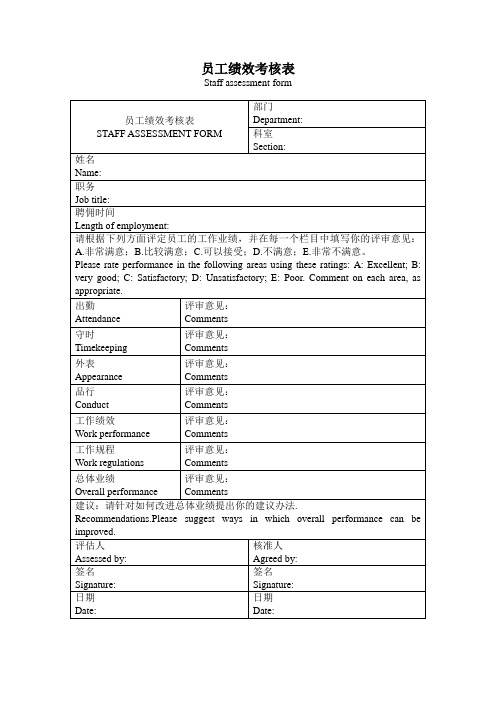
评估人
Assessed by:
核准人
Agreed by:
签名
Signature:
签名
Signature:
日期
Date:
日期
Date:
出勤
Attendance
评审意见:
Comments
守时
Timekeeping
评审意见:
Comments外表A来自pearance评审意见:
Comments
品行
Conduct
评审意见:
Comments
工作绩效
Work performance
评审意见:
Comments
工作规程
Work regulations
评审意见:
Comments
总体业绩
Overall performance
评审意见:
Comments
建议:请针对如何改进总体业绩提出你的建议办法.
Recommendations.Please suggest ways in which overall performance can be improved.
员工绩效考核表
Staff assessment form
员工绩效考核表
STAFF ASSESSMENT FORM
部门
绩效考核方案中英双语

XX绩效考核方案XX Performance Assessment Plan一、考核算施目旳The assessment objective1.作为员工薪资调整、绩效奖金发放、职务调整旳根据。
As the basis of employees’ salary adjustment, performance bonus, position adjustment 2.有效增长员工之间旳合作精神,对员工全面旳工作进行客观理解和公正评价。
Increase the team spirit between the employees ; know and evaluate employees’ job effectively3.协助员工改善工作方式,提高工作绩效。
Help employee improve the work way and work efficiency二、合用范围Scope of application企业所有高级经理级及如下员工。
All the senior managers and employees三、考核频率Assessment frequency1.季度考核,对当季度旳工作体现进行考核,考核算施时间为下月旳1~5日,遇节假日顺延。
Quarter assessment, assess the work performance in the quarter, the assessment date is September 1-5 and will be put off if it is holiday.四、考核内容Assessment content1.工作业绩work achievement2.工作能力work ability3.工作态度work attitude4.合作配合work cooperation5.自我提高self-improvement以上为基本考核内容,详细详情另见考核附件Above is the basic assessment content, the details is as the follow ’s assessment attachment五、评分对照Score compare考核分数对照表Assessment score form六、考核算施Assessment carrying out1.考核算施及考查对象配比Assessment carrying out and object matching备注:总部各部门负责人由CEO直接考核。
绩效考核的五个标准英文缩写
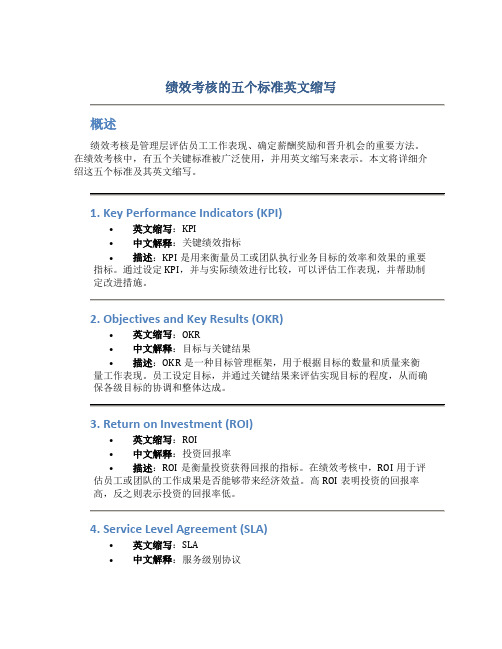
绩效考核的五个标准英文缩写概述绩效考核是管理层评估员工工作表现、确定薪酬奖励和晋升机会的重要方法。
在绩效考核中,有五个关键标准被广泛使用,并用英文缩写来表示。
本文将详细介绍这五个标准及其英文缩写。
1. Key Performance Indicators (KPI)•英文缩写:KPI•中文解释:关键绩效指标•描述:KPI是用来衡量员工或团队执行业务目标的效率和效果的重要指标。
通过设定KPI,并与实际绩效进行比较,可以评估工作表现,并帮助制定改进措施。
2. Objectives and Key Results (OKR)•英文缩写:OKR•中文解释:目标与关键结果•描述:OKR是一种目标管理框架,用于根据目标的数量和质量来衡量工作表现。
员工设定目标,并通过关键结果来评估实现目标的程度,从而确保各级目标的协调和整体达成。
3. Return on Investment (ROI)•英文缩写:ROI•中文解释:投资回报率•描述:ROI是衡量投资获得回报的指标。
在绩效考核中,ROI用于评估员工或团队的工作成果是否能够带来经济效益。
高ROI表明投资的回报率高,反之则表示投资的回报率低。
4. Service Level Agreement (SLA)•英文缩写:SLA•中文解释:服务级别协议•描述:SLA是一种合同协议,规定了服务提供方应满足的各种服务标准和好的表现。
在绩效考核中,SLA用于衡量员工或团队提供的服务质量是否达到了预期水平。
5. Key Result Areas (KRA)•英文缩写:KRA•中文解释:关键结果领域•描述:KRA是工作职责的重要领域或关键要素。
在绩效考核中,KRA被用于确定员工应该专注和取得成果的关键领域。
通过评估KRA的完成情况,可以客观地评估员工的工作表现。
结论绩效考核的五个标准英文缩写提供了一种有组织且标准化的方式来衡量员工工作表现。
了解并应用这些缩写,可以帮助管理层更全面地评估员工的工作表现,并为员工提供明确的改进目标。
绩效评估表-中英文对照版

Substantially Exceeded
Expectations
持续超越期望
Performance was consistently exceptional in most evaluation categories. Employee demonstrated personal initiative in attaining superior results, far beyond expectation.业绩持续超越评定标准。员工在达成卓越结果中,积极主动。远远超出预期。
2.Do you have any obstacles when achieving your goals? If yes, please describe, and how youovercome these obstacles.
在达成目标时是否遇到什么阻碍?如果有,请具体描述,并说明您是如何克服阻碍?
我已经和我的直线经理完成了业绩评估,并且同意以上所有意见
Employee Name, Signature and Date:
员工姓名、签名和日期:
Manager Name, Signature and Date:
经理姓名、签名和日期:
PROFESSIONAL DEVELOPMENT DIALOG & FOLLOW UP ACTIONS
Shape vision & strategy制定愿景和战略
Drive change & innovation驾驭变革和创新
Build capability for future为未来提高能力
IMPLEMENTATION执行力Rating评分: _________
Business Acumen商业敏感
员工绩效考核方案-中英文对照
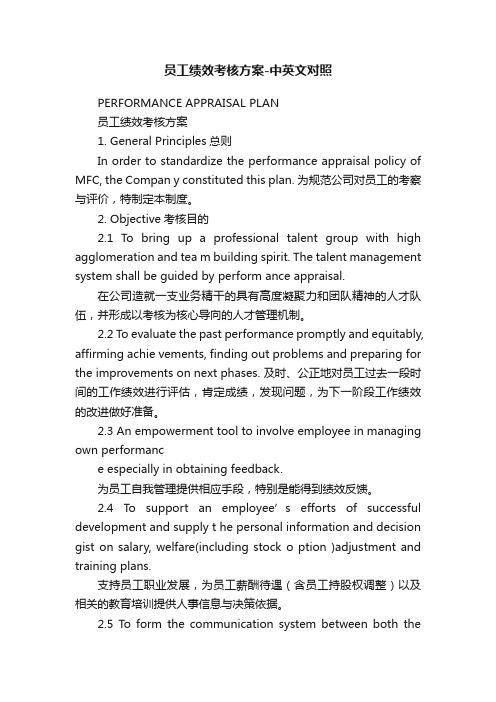
员工绩效考核方案-中英文对照PERFORMANCE APPRAISAL PLAN员工绩效考核方案1. General Principles总则In order to standardize the performance appraisal policy of MFC, the Compan y constituted this plan. 为规范公司对员工的考察与评价,特制定本制度。
2. Objective考核目的2.1 To bring up a professional talent group with high agglomeration and tea m building spirit. The talent management system shall be guided by perform ance appraisal.在公司造就一支业务精干的具有高度凝聚力和团队精神的人才队伍,并形成以考核为核心导向的人才管理机制。
2.2 To evaluate the past performance promptly and equitably, affirming achie vements, finding out problems and preparing for the improvements on next phases. 及时、公正地对员工过去一段时间的工作绩效进行评估,肯定成绩,发现问题,为下一阶段工作绩效的改进做好准备。
2.3 An empowerment tool to involve employee in managing own performance especially in obtaining feedback.为员工自我管理提供相应手段,特别是能得到绩效反馈。
2.4 To support an employee’s efforts of successful development and supply t he personal information and decision gist on salary, welfare(including stock o ption )adjustment and training plans.支持员工职业发展,为员工薪酬待遇(含员工持股权调整)以及相关的教育培训提供人事信息与决策依据。
(完整word版)绩效考核外文文献及翻译

绩效考核外文文献及翻译外文文献1.Performance appraisals - purpose and how to make it easier Performance appraisals are essential for the effective management and evaluation of staff. Appraisals help develop individuals, improve organizational performance, and feed into business planning. Formal performance appraisals are generally conducted annually for all staff in the organization. His or her line manager appraises each staff member. Directors are appraised by the CEO, who is appraised by the chairman or company owners, depending on the size and structure of the organization. Annual performance appraisals enable management and monitoring of standards, agreeing expectations and objectives, and delegation of responsibilities and tasks. Staff performance appraisals also establish individual training needs and enable organizational training needs analysis and planning. Performance appraisals also typically feed into organizational annual pay and grading reviews, which commonly also coincide with the business planning for the next trading year. Performance appraisals generally review each individual's performance against objectives and standards for the trading year, agreed at the previous appraisal meeting. Performance appraisals are also essential for career and succession planning - for individuals, crucial jobs, and for the organization as a whole. Performance appraisals are important for staff motivation, attitude and behavior development, communicating and aligning individual and organizational aims, and fostering positive relationships between management and staff. Performance appraisals provide a formal, recorded, regular review of an individual's performance, and a plan for future development. Job performance appraisals - in whatever form they take - are therefore vital for managing the performance of people and organizations. Managers and appraises commonly dislike appraisals and try to avoid them. To these people the appraisal is daunting and time-consuming. The process is seen as a difficult administrative chore and emotionally challenging. The annual appraisal is maybe the only time since last year that the two people have sat down together for a meaningful one-to-one discussion. No wonder then that appraisals are stressful - which then defeats the whole purpose. Appraisals are much easier, and especially more relaxed, if the boss meets each of the team members individually and regularly for one-to-one discussion throughout the year. Meaningful regular discussion about work, career, aims, progress, development, hopes and dreams, life, the universe, the TV, common interests, etc., whatever, makes appraisals so much easier because people then know and trust each other - which reduces all the stress and the uncertainty. Put off discussions and of course they loom very large. So don't wait for the annual appraisal to sit down and talk. The boss or the appraises can instigate this. If you are an employee with a shy boss, then take the lead. If you are a boss who rarely sits down and talks with people - or whose people are not used to talking with their boss - then set about relaxing the atmosphere and improving relationships. Appraisals (and work) all tend to be easier when people communicate well and know each other. So sit down together and talk as often as you can, and then when the actual formal appraisals are due everyone will find the whole process to be far more natural, quick, and easy - and a lot more productive too. 2.Appraisals, social responsibility and whole-person development There is increasingly a need for performance appraisals of staff and especially managers, directors and CEO's, to include accountabilities relating to corporate responsibility, represented by various converging corporate responsibility concepts including: the “Triple Bottom Line”; corporate so cial responsibility (CSR); Sustainability; corporate integrity and ethics; Fair Trade, etc. The organization must decide the extent to which these accountabilities are reflected in job responsibilities, which would thennaturally feature accordingly in performance appraisals. More about this aspect of responsibility is in the directors’ job descriptions section. Significantly also, while this appraisal outline is necessarily a formal structure this does not mean that the development discussed with the appraises must be formal and constrained. In fact the opposite applies. Appraisals must address “whole person” development - not just job skills or the skills required for the next promotion. Appraisals must not discriminate against anyone on the grounds of age, gender, sexual orientation, race, religion, disability, etc. The UK Employment Equality (Age) Regulations 2006, (consistent with Europe), effective from 1st October 2006, make it particularly important to avoid any comments, judgments, suggestions, questions or decisions which might be perceived by the appraises to be based on age. This means people who are young as well as old. Age, along with other characteristics stated above, is not a lawful basis for assessing and managing people, unless proper 'objective justification' can be proven. See the Age Diversity information. When designing or planning and conducting appraisals, seek to help the 'whole-person' to grow in whatever direction they want, not just to identify obviously relevant work skills training. Increasingly, the best employers recognize that growing the 'whole person' promotes positive attitudes, advancement, motivation, and also develops lots of new skills that can be surprisingly relevant to working productively and effectively in any sort of organization. Developing the whole-person is also an important aspect of modern corporate responsibility, and separately (if you needed a purely business-driven incentive for adopting these principles), whole-person development is a crucial advantage in the employment market, in which all employers compete to attract the best recruits, and to retain the best staff. Therefore in appraisals, be creative and imaginative in discussing, discovering and agreeing 'whole-person' development that people will respond to, beyond the usual job skill-set, and incorporate this sort of development into the appraisal process. Abraham Maslow recognized this over fifty years ago. If you are an employee and your employer has yet to embrace or even acknowledge these concepts, do them a favor at your own appraisal and suggest they look at these ideas, or maybe mention it at your exit interview prior to joining a better employer who cares about the people, not just the work. Incidentally the Multiple Intelligences test and V AK Learning Styles test are extremely useful tools for appraisals, before or after, to help people understand their natural potential and strengths and to help managers understand this about their people too. There are a lot of people out there who are in jobs which don't allow them to use and develop their greatest strengths; so the more we can help folk understand their own special potential, and find roles that really fit well, the happier we shall all be. 3 .Are performance appraisals still beneficial and appropriate It is sometimes fashionable in the 'modern age' to dismiss traditional processes such as performance appraisals as being irrelevant or unhelpful. Be very wary however if considering removing appraisals from your own organizational practices. It is likely that the critics of the appraisal process are the people who can't conduct them very well. It's a common human response to want to jettison something that one finds difficult. Appraisals - in whatever form, and there are various - have been a mainstay of management for decades, for good reasons. Think about everything that performance appraisals can achieve and contribute to when they are properly managed, for example: (1)performance measurement - transparent, short, medium and long term (2)clarifying, defining, redefining priorities and objectives (3)motivation through agreeing helpful aims and targets (4)motivation though achievement and feedback (5)training needs and learning desires - assessment and agreement (6)identification of personal strengths and direction - including unused hidden strengths (7)career and succession planning -personal and organizational (8)team roles clarification and team building (9)organizational training needs assessment and analysis (10)appraise and manager mutual awareness, understanding and relationship (11)resolving confusions and misunderstandings (12)reinforcing and cascading organizational philosophies, values, aims, strategies, priorities, etc (13)delegation, additional responsibilities, employee growth and development (14)counseling and feedback (15)manager development - all good managers should be able to conduct appraisals well - it's a fundamental process (16)the list goes on People have less and less face-to-face time together these days. Performance appraisals offer a way to protect and manage these valuable face-to-face opportunities. My advice is to hold on to and nurture these situations, and if you are under pressure to replace performance appraisals with some sort of (apparently) more efficient and cost effective methods, be very sure that you can safely cover all the aspects of performance and attitudinal development that a well-run performance appraisals system is naturally designed to achieve. There are various ways of conducting performance appraisals, and ideas change over time as to what are the most effective appraisals methods and systems. Some people advocate traditional appraisals and forms; others prefer 360-degree-type appraisals; others suggest using little more than a blank sheet of paper. In fact performance appraisals of all types are effective if they are conducted properly, and better still if the appraisal process is clearly explained to, agreed by, the people involved. Managers need guidance, training and encouragement in how to conduct appraisals properly. Especially the detractors and the critics. Help anxious managers (and directors) develop and adapt appraisals methods that work for them. Be flexible. There are lots of ways to conduct appraisals, and particularly lots of ways to diffuse apprehension and fear - for managers and appraises alike. Particularly - encourage people to sit down together and review informally and often - this removes much of the pressure for managers and appraises at formal appraisals times. Leaving everything to a single make-or-break discussion once a year is asking for trouble and trepidation. Look out especially for the warning signs of 'negative cascaded attitudes' towards appraisals. This is most often found where a senior manager or director hates conducting appraisals, usually because they are uncomfortable and inexperienced in conducting them. The senior manager/director typically will be heard to say that appraisals don't work and are a waste of time, which for them becomes a self-fulfilling prophecy. All that said, performance appraisals that are administered without training (for those who need it), without explanation or consultation, and conducted poorly will be counter-productive and is a waste of everyone's time. Well-prepared and well-conducted performance appraisals provide unique opportunities to help appraise and managers improve and develop, and thereby also the organizations for whom they work. Just like any other process, if performance appraisals aren't working, don't blame the process, ask yourself whether it is being properly trained, explained, agreed and conducted. 4. Effective performance appraisals Aside from formal traditional (annual, six-monthly, quarterly, or monthly) performance appraisals, there are many different methods of performance evaluation. The use of any of these methods depends on the purpose of the evaluation, the individual, the assessor, and the environment. The formal annual performance appraisal is generally the over-riding instrument, which gathers together and reviews all other performance data for the previous year. Performance appraisals should be positive experiences. The appraisals process provides the platform for development and motivation, so organizations should foster a feeling that performance appraisals are positive opportunities, in order to get the best out of the people and the process. In certain organizations, performance appraisals are widely regarded as something rather less welcoming('blocking sessions' is not an unusual description), which provides a basis only on which to develop fear and resentment, so never, never, never use a staff performance appraisal to handle matters of discipline or admonishment, which should instead be handled via separately arranged meetings. 5. Types of performance and aptitude assessments (1)Formal annual performance appraisals (2)Probationary reviews (3)Informal one-to-one review discussions (4)Counseling meetings (5) Observation post (6) Skills or career-related tests (7) Assignment or task to follow the review, including the secondment (8)Assessment Centre, including the observation group exercises, presentations and other tests (9)Communicate with people who investigate the views of others (10) Acts of psychological tests and other assessment (11)Handwriting analysis 外文文献译文1、考绩考核的用途和如何使其易于实现绩效考核根本上是对职员有效的管理和评估。
员工绩效考核方案-中英文对照

员工绩效考核方案-中英文对照PERFORMANCE APPRAISAL PLAN员工绩效考核方案1. General Principles总则In order to standardize the performance appraisal policy of MFC, the Compan y constituted this plan. 为规范公司对员工的考察与评价,特制定本制度。
2. Objective考核目的2.1 To bring up a professional talent group with high agglomeration and tea m building spirit. The talent management system shall be guided by perform ance appraisal.在公司造就一支业务精干的具有高度凝聚力和团队精神的人才队伍,并形成以考核为核心导向的人才管理机制。
2.2 To evaluate the past performance promptly and equitably, affirming achie vements, finding out problems and preparing for the improvements on next phases. 及时、公正地对员工过去一段时间的工作绩效进行评估,肯定成绩,发现问题,为下一阶段工作绩效的改进做好准备。
2.3 An empowerment tool to involve employee in managing own performance especially in obtaining feedback.为员工自我管理提供相应手段,特别是能得到绩效反馈。
2.4 To support an employee’s efforts of successful development and supply t he personal information and decision gist on salary, welfare(including stock o ption )adjustment and training plans.支持员工职业发展,为员工薪酬待遇(含员工持股权调整)以及相关的教育培训提供人事信息与决策依据。
绩效考核标准(中英文)
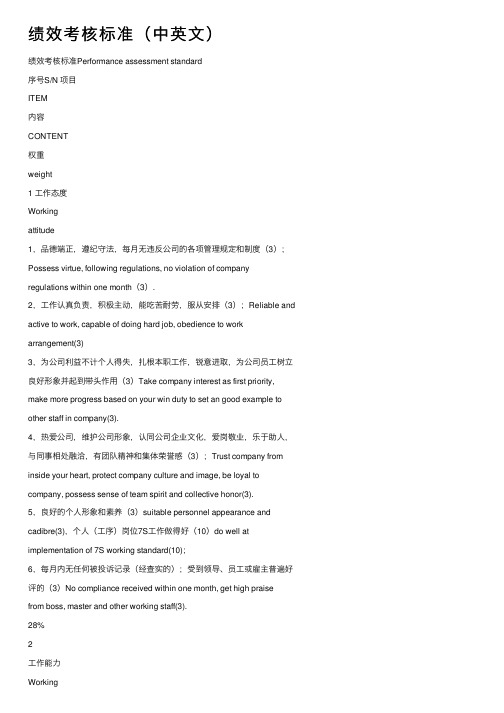
绩效考核标准(中英⽂)绩效考核标准Performance assessment standard序号S/N 项⽬ITEM内容CONTENT权重weight1 ⼯作态度Workingattitude1,品德端正,遵纪守法,每⽉⽆违反公司的各项管理规定和制度(3);Possess virtue, following regulations, no violation of company regulations within one month(3).2,⼯作认真负责,积极主动,能吃苦耐劳,服从安排(3);Reliable and active to work, capable of doing hard job, obedience to work arrangement(3)3,为公司利益不计个⼈得失,扎根本职⼯作,锐意进取,为公司员⼯树⽴良好形象并起到带头作⽤(3)Take company interest as first priority, make more progress based on your win duty to set an good example to other staff in company(3).4,热爱公司,维护公司形象,认同公司企业⽂化,爱岗敬业,乐于助⼈,与同事相处融洽,有团队精神和集体荣誉感(3);Trust company from inside your heart, protect company culture and image, be loyal to company, possess sense of team spirit and collective honor(3).5,良好的个⼈形象和素养(3)suitable personnel appearance and cadibre(3),个⼈(⼯序)岗位7S⼯作做得好(10)do well at implementation of 7S working standard(10);6,每⽉内⽆任何被投诉记录(经查实的);受到领导、员⼯或雇主普遍好评的(3)No compliance received within one month, get high praise from boss, master and other working staff(3).28%2⼯作能⼒Workingcapability8,⽣产的重点就是平衡产量和质量,不能要求产量忽视了质量,也不能因质量忽视了产量,达到并超过专业技能或业务⽔平优秀,完全胜任本职⼯作,把质量放到⾸位;The most important point of production is tokeep balance between product quality and quantity.(考核办法:按返⼯、修复频次和数量核算,找不到责任⼈,班组长承担所有罚款,每个罚款?10,再每个扣1分,扣完为⽌,如果已外发客户因质量问题退回返⼯,每个罚款?20 Assessment rules: for each unqualifiedproduct, the person who is responsible will be fined 10 NAIRAS andlose 1 point, until all available points are gone. For eachunqualified product which is detected by customer, the fine wouldbe 20 NAIRAS. Squad leader will be responsible for the fine if thedirect responsible cannot be found )20%DISCOVERY INTERNATIONAL FZE拓展国际⾃贸区公司1,每⽉统计在案,并适时张榜公布,做到公平公正;Assessment statics record will be made and published every month in order to keep open and fair.2,作为每⽉绩效评估依据,确定每⽉绩效津贴(100分,NGN3000元)发放⾦额;The allowance base for monthly assessment is 100 points and 3000 NAIRAS.3,试⾏期间只考核⼯序组长及以上职位的员⼯。
绩效考核表(中英文)
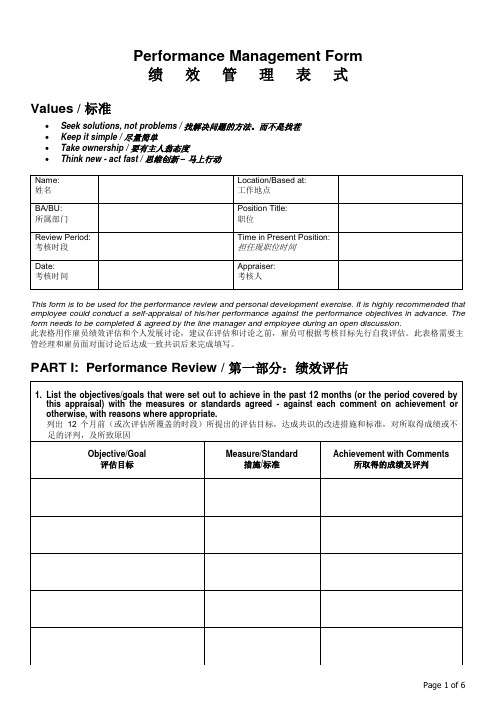
Performance Management Form绩效管理表式Values / 标准•Seek solutions, not problems / 找解决问题的方法。
而不是找茬•Keep it simple / 尽量简单•Take ownership / 要有主人翁态度•Think new - act fast / 思维创新–马上行动This form is to be used for the performance review and personal development exercise. It is highly recommended that employee could conduct a self-appraisal of his/her performance against the performance objectives in advance. The form needs to be completed & agreed by the line manager and employee during an open discussion.此表格用作雇员绩效评估和个人发展讨论,建议在评估和讨论之前,雇员可根据考核目标先行自我评估。
此表格需要主管经理和雇员面对面讨论后达成一致共识后来完成填写。
PART I: Performance Review / 第一部分:绩效评估PART II: Personal Training and Development第二部分:培训和发展Appraisee’s signature Date 被考核人签字:日期:Appraiser’s signature Date 考核人签字:日期:Manager’s signature: Date 主观经理签字:日期:。
2024年版的企业绩效评价标准英文版

2024年版的企业绩效评价标准英文版Document Title: 2024 Edition of Corporate Performance Evaluation StandardsIn today's rapidly changing business environment, it is essential for companies to have a robust performance evaluation system in place to ensure growth and success. The following document outlines the updated standards for evaluating corporate performance in 2024.Key Performance Indicators (KPIs)- Revenue Growth: Measure the increase in revenue over a specific period to gauge the company's financial health.- Profit Margin: Evaluate the company's profitability by calculating the percentage of profit earned on each dollar of revenue.- Customer Satisfaction: Monitor and assess customer feedback to ensure high levels of satisfaction and loyalty.- Employee Engagement: Measure the level of employee commitment and motivation to drive productivity and innovation.- Market Share: Determine the company's position in the market by analyzing its share of total sales.Performance Evaluation Process1. Define Clear Objectives: Set specific and measurable goals that align with the company's overall strategy.2. Collect Data: Gather relevant data and information to assess performance against the established KPIs.3. Analyze Results: Evaluate the data to identify strengths, weaknesses, and areas for improvement.4. Implement Action Plans: Develop strategies to address any performance gaps and enhance overall performance.5. Monitor Progress: Continuously track performance metrics and make adjustments as needed to achieve desired outcomes.Performance Rating Scale- Exceptional: Exceeds expectations and consistently achieves outstanding results.- Satisfactory: Meets expectations and consistently delivers solid performance.- Needs Improvement: Falls short of expectations and requires corrective action to improve performance.- Unsatisfactory: Fails to meet expectations and demonstrates significant deficiencies in performance.Performance Review Frequency- Quarterly Reviews: Conduct regular performance evaluations every quarter to track progress and make timely adjustments.- Annual Appraisals: Hold comprehensive performance reviews annually to assess overall performance and set goals for the upcoming year.ConclusionBy implementing these updated performance evaluation standards, companies can effectively measure and enhance their corporate performance in 2024. It is crucial for organizations to adapt to changing market conditions and continuously improve to stay competitive and achieve long-term success.。
全版:采购部门绩效考核标准英文版
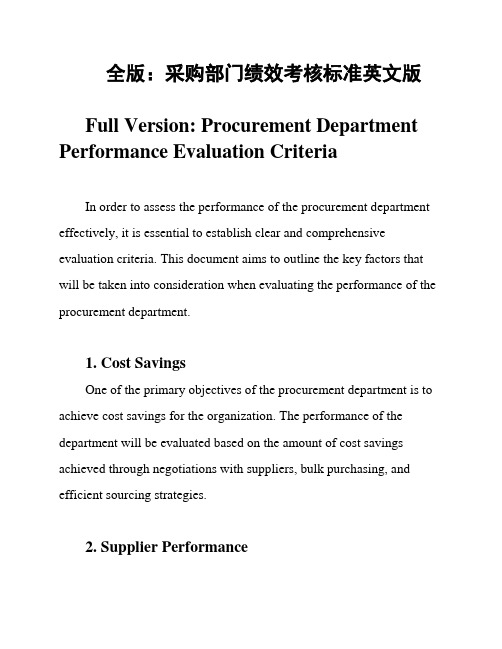
全版:采购部门绩效考核标准英文版Full Version: Procurement Department Performance Evaluation CriteriaIn order to assess the performance of the procurement department effectively, it is essential to establish clear and comprehensive evaluation criteria. This document aims to outline the key factors that will be taken into consideration when evaluating the performance of the procurement department.1. Cost SavingsOne of the primary objectives of the procurement department is to achieve cost savings for the organization. The performance of the department will be evaluated based on the amount of cost savings achieved through negotiations with suppliers, bulk purchasing, and efficient sourcing strategies.2. Supplier PerformanceThe procurement department plays a crucial role in maintaining strong relationships with suppliers. The performance of the department will be assessed based on the quality of supplier relationships, on-time delivery rates, and the ability to resolve any issues or disputes effectively.3. ComplianceEnsuring compliance with relevant laws, regulations, and organizational policies is essential for the procurement department. Performance will be evaluated based on adherence to procurement guidelines, ethical sourcing practices, and risk management procedures.4. Process EfficiencyEfficient procurement processes are key to the overall success of the department. Performance will be measured based on the speed of procurement activities, accuracy of documentation, and the implementation of streamlined processes to improve efficiency.5. Stakeholder SatisfactionThe satisfaction of internal stakeholders, such as end-users and department heads, is crucial for the procurement department. Performance will be assessed based on feedback from stakeholders, responsiveness to their needs, and the ability to meet their expectations in a timely manner.6. InnovationInnovation in procurement practices can lead to significant improvements in cost savings and efficiency. The performance of the department will be evaluated based on the implementation of innovative sourcing strategies, technology adoption, and continuous improvement initiatives.ConclusionBy establishing clear and comprehensive evaluation criteria for the procurement department, organizations can effectively assess performance, identify areas for improvement, and drive overall success in procurement activities.。
绩效考核办法绩效考核制度中英文
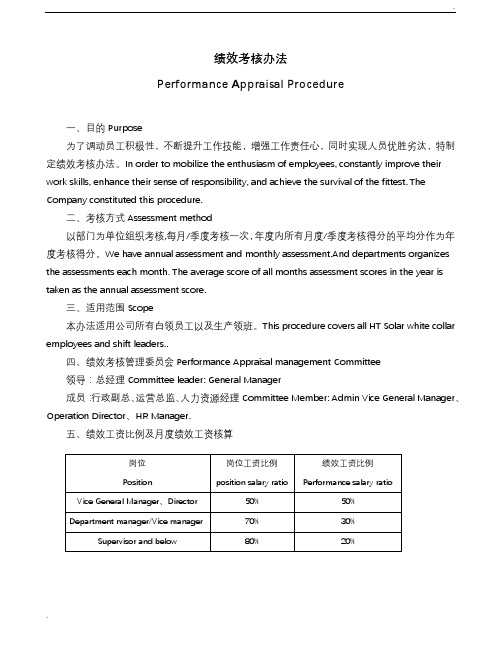
绩效考核办法Performance Appraisal Procedure一、目的Purpose为了调动员工积极性,不断提升工作技能,增强工作责任心,同时实现人员优胜劣汰,特制定绩效考核办法。
In order to mobilize the enthusiasm of employees, constantly improve their work skills, enhance their sense of responsibility, and achieve the survival of the fittest.The Company constituted this procedure.二、考核方式Assessment method以部门为单位组织考核,每月/季度考核一次,年度内所有月度/季度考核得分的平均分作为年度考核得分。
We have annual assessment and monthly assessment.And departments organizes the assessments each month. The average score of all months assessment scores in the year is taken as the annual assessment score.三、适用范围Scope本办法适用公司所有白领员工以及生产领班。
This procedure covers all HT Solar white collar employees and shift leaders..四、绩效考核管理委员会Performance Appraisal management Committee领导:总经理Committee leader: General Manager成员:行政副总、运营总监、人力资源经理Committee Member: Admin Vice General Manager、Operation Director、HR Manager.五、绩效工资比例及月度绩效工资核算月度绩效工资=工资标准*绩效工资比例*月度绩效得分*100%Monthly performance salary = standard salary * performance salary ratio * monthly performance scores /100六、考核周期:Assessment cycle月度考核:自每月1日到月末最后一天。
- 1、下载文档前请自行甄别文档内容的完整性,平台不提供额外的编辑、内容补充、找答案等附加服务。
- 2、"仅部分预览"的文档,不可在线预览部分如存在完整性等问题,可反馈申请退款(可完整预览的文档不适用该条件!)。
- 3、如文档侵犯您的权益,请联系客服反馈,我们会尽快为您处理(人工客服工作时间:9:00-18:30)。
绩效考核标准Performance assessment standard
序号S/N 项目
ITEM
内容
CONTENT
权重
weight
1 工作态度
Working
attitude
1,品德端正,遵纪守法,每月无违反公司的各项管理规定和制度(3);
Possess virtue, following regulations, no violation of company
regulations within one month(3).
2,工作认真负责,积极主动,能吃苦耐劳,服从安排(3);Reliable and
active to work, capable of doing hard job, obedience to work
arrangement(3)
3,为公司利益不计个人得失,扎根本职工作,锐意进取,为公司员工树立
良好形象并起到带头作用(3)Take company interest as first priority,
make more progress based on your win duty to set an good example to
other staff in company(3).
4,热爱公司,维护公司形象,认同公司企业文化,爱岗敬业,乐于助人,
与同事相处融洽,有团队精神和集体荣誉感(3);Trust company from
inside your heart, protect company culture and image, be loyal to
company, possess sense of team spirit and collective honor(3).
5,良好的个人形象和素养(3)suitable personnel appearance and
cadibre(3),个人(工序)岗位7S工作做得好(10)do well at
implementation of 7S working standard(10);
6,每月内无任何被投诉记录(经查实的);受到领导、员工或雇主普遍好
评的(3)No compliance received within one month, get high praise
from boss, master and other working staff(3).
28%
2
工作能力
Working
capability
8,生产的重点就是平衡产量和质量,不能要求产量忽视了质量,也不能
因质量忽视了产量,达到并超过专业技能或业务水平优秀,完全胜任本职
工作,把质量放到首位;The most important point of production is to
keep balance between product quality and quantity.
(考核办法:按返工、修复频次和数量核算,找不到责任人,班组长承担
所有罚款,每个罚款₦10,再每个扣1分,扣完为止,如果已外发客户因质
量问题退回返工,每个罚款₦20 Assessment rules: for each unqualified
product, the person who is responsible will be fined 10 NAIRAS and
lose 1 point, until all available points are gone. For each
unqualified product which is detected by customer, the fine would
be 20 NAIRAS. Squad leader will be responsible for the fine if the
direct responsible cannot be found )
20%
DISCOVERY INTERNATIONAL FZE
拓展国际自贸区公司
1,每月统计在案,并适时张榜公布,做到公平公正;Assessment statics record will be made and published every month in order to keep open and fair.
2,作为每月绩效评估依据,确定每月绩效津贴(100分,NGN3000元)发放金额;The allowance base for monthly assessment is 100 points and 3000 NAIRAS.
3,试行期间只考核工序组长及以上职位的员工。
Only procedure squad leaders and staff who are with superior position will take part in the assessment during trial implementation period.
三、年终评估:yearly assessment
1,作为每年绩效评估依据,根据公司经营状况,确定是否发放年终奖金;This assessment result will be taken as appraisal basis which can decide whether the year-end bonus will be provided.
2,作为年终优秀员工评估依据,颁发荣誉证书,荣誉奖牌,给予物质奖励或现金奖励。
Excellent employ will be awarded with honor credential, medal and material or cash rewards.
四、执行日期effective date:
1,试行开始日期2020年10月02日 Trial implementation start date:Oct 2,2020;
2,全员执行日期2021年01月02日 Full scale implementation date: Jan 2,2021 。
批准approved by:。
